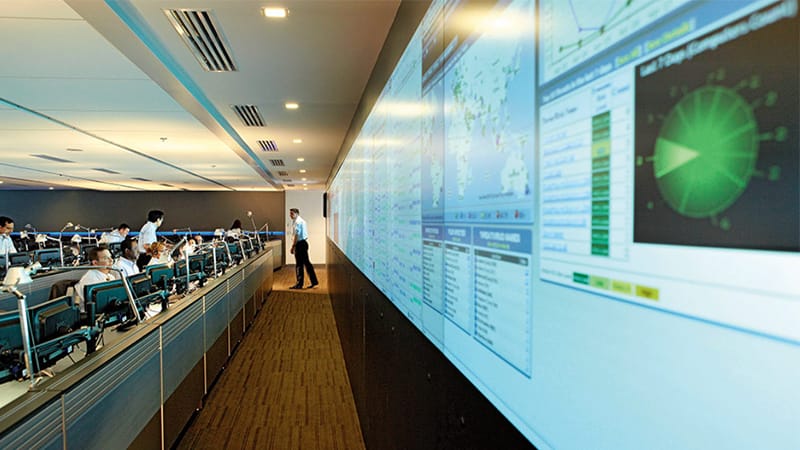
3 Ways to Increase Productivity in the Control Room
Control rooms act like the central nervous systems of many organizations and facilities, where critical decisions are made using complex systems. In order to optimize decision-making, operators need a comfortable work environment and the right tools. This article explores how to boost control room productivity quickly and enhance operator productivity in control room design with 3 best practices sourced from experts in the field.
With an optimal setup in place, control room teams can quickly diagnose, react to, and resolve abnormal situations, detecting issues before they escalate.
Operational Modes to Enhance Control Room Productivity
Researchers Schulman and Roy wrote a study proposing a metric for evaluating crises involving response from control rooms. In it, they underscore the critical role of effective control room operations in ensuring reliability, managing complex systems, and supporting economic activities. The study further explains that control room operators manage high input fluctuation to produce low output variance, which is crucial for maintaining stable and reliable performance.
As a result, there are two principal operation modes in a 24/7 control room environment designed to facilitate the experience of control room operators in such high-pressure situations:
- Anticipation and Prevention: Operators primarily anticipate and prevent critical events, frequently re-evaluating and adjusting processes. Productivity here relies on operator alertness and having the right tools for easy process adjustments.
- Crisis Management: Operators are the first line of response during critical events, requiring quick and timely reactions. Productivity during crises depends on rapid response capabilities.
Given the importance of the work that control room operators do, it is essential to consider the design of the control room itself and how it impacts the well-being and effectiveness of the operators within it.
1. Ergonomic Control Room Design and Operator Well-being
Control room operators handle demanding tasks, monitoring, controlling, and making decisions about complex systems. Since many control rooms operate 24/7, 365 days a year, ergonomic design is crucial to reduce distractions and human error.
Ergonomic Consoles for Operator Comfort
Promote Movement: Operators are often subject to higher stress, fatigue, and anxiety. Ergonomic consoles with height-adjustable surfaces allow operators to stand, stretch, and adjust their workspace, reducing stress, fatigue, and anxiety. Memory presets on sit/stand controllers facilitate faster transitions between shifts and accommodate operators of different heights or disabilities.
Personal Environmental Control: The majority of the complaints in a workspace are related to the ambient temperature and can greatly affect the performance of operators.
Individual temperature preferences vary, and centrally controlled facilities often cannot accommodate everyone. Personal environmental systems like VuWall’s V-IO Box allow operators to control their temperature and lighting directly at their consoles, improving comfort and performance.
Create Spacious Work Areas: Control room layout is also crucial. Clutter-free environments minimize distractions. Tangible factors include furniture dimensions, cable management, and monitor sizes, while intangible factors include noise, lighting, colors, and the overall atmosphere.
Dual-surface consoles, often used with video wall management systems like VuScape, provide primary and secondary workspaces, enhancing comfort and efficiency. Ample storage space helps operators organize personal belongings, fostering a sense of ownership.
2. Centralized Visualization and Video Wall Management
Imagine a control room where all systems are synchronized for unified response during major events. Operators need to control content on the video wall, including security cameras, media feeds, and geo-mapping data, to ensure safety and accuracy.
Centralized, integrated, and interoperable video wall control systems like VuWall’s TRx enhance team efficiency and collaboration with increased visibility.
Simplified Central Platform
Traditionally, the video wall was used as a static display. Modern control rooms use video walls as dynamic tools, aided by KVM (keyboard, video, mouse) nodes and video processors like VuWall’s PAK.
Operators need to manage video walls as easily as their desktops. Solutions should minimize technological complexity, allowing operators to focus on their mission-critical tasks. Key features of an effective system include:
-
Intuitive Interface: Simple, intuitive interfaces reduce training time and increase operator efficiency.
-
No Programming Required: Drag-and-drop interfaces for easy preset creation and launch from a control panel.
-
Focus on the Mission: Operators should easily display any visual content from any source on any display. Hybrid technology is essential for processing IP, AV, and IT sources simultaneously across different display resolutions and aspect ratios. VuWall’s VuTrex technology is designed to achieve this.
VMS Integration
Many security monitoring facilities use Video Management Systems (VMS) like Genetec or Milestone. Video wall management software that integrates with the VMS streamlines operations and provides a unified visualization experience.
VuWall has integrations with Milestone and Genetec to allow security monitoring operators to control all the sources on their video wall (and not just the security cameras) from a single already-familiar interface. You can learn more about VuWall in the Genetec Hub.
Focus On The Mission, Not The Technology.
Operators shouldn’t have to worry about technology. They should be able to grab any visual content, whether a camera, an application, or a dashboard, and easily display it on any surface.
You’d think that’s obvious, but few video wall controllers are able to process IP, AV and IT sources simultaneously while handling display surfaces of different resolutions and aspect ratios. This functionality is called hybrid technology: grabbing any source type and visualizing it on any display. Watch the video to learn more.
3. Automation and Unattended Monitoring
The biggest challenge in control rooms is the increasing amount of data: the “Big Data”. With so much information to process, it is impossible for the human eye to catch it all. That’s where automation comes in.
It starts with reducing repetitive manual tasks, but then how do you react to alarms and alerts faster? By seeing the most critical sources of information quicker while keeping a birds-eye view of the situation.
Here are two ways to increase productivity through visualization automation.
Unattended Monitoring
Most monitoring software includes some automation, but not between different systems that aren’t already integrated. That creates a challenge when your goal is to trigger an event based on a combination of signals from different systems.
Example: In a traffic monitoring center, an alarm from a failed traffic light system combined with a stalled vehicle detected by a video management system could trigger a more critical response.
Systems using color detection software can identify color changes on screens or video walls from multiple applications to process such combinations.
Customized Automation
Control rooms need easy programming for repetitive tasks like opening layouts on specific video walls, switching audio signals, or adjusting video wall layouts and room lighting for shift changes.
Commands should be easily triggered via control panels. Customizable touch panels, like VuWall’s ControlVu, and software, like TRx, enable operators and supervisors to create ad-hoc control panels without programming, saving time and improving response times.
Summary
Modern control rooms require smart, unified technology systems that also prioritize operator well-being. This combination increases productivity, reduces errors, and speeds up responses to critical events. Effective data sharing and visualization are essential for timely and informed decision-making.
Select video wall software that has an easy way to create such macro-commands without the need for programming. The last thing you want is to have to hire a programmer every time your procedures change. Operators and supervisors should be able to create ad-hoc fully customizable control panels as they encounter new scenarios and as work procedures evolve.
The effectiveness of sharing and visualizing data in a control room environment can have serious implications as operators need to have the ability to control what they see when they need to see it in order to make better and more informed decisions.
 English
English German
German French
French Spanish
Spanish








